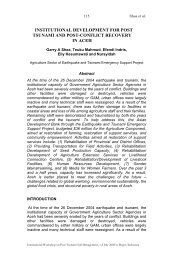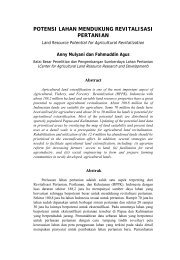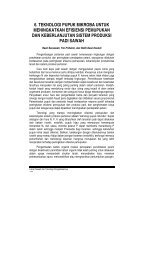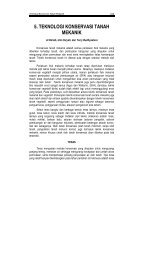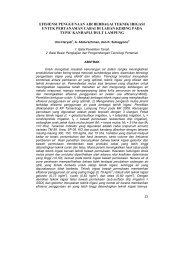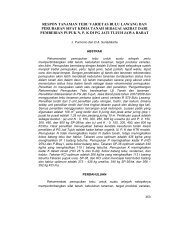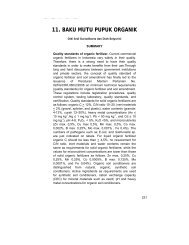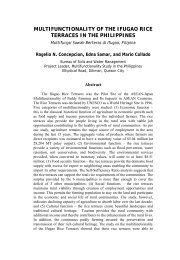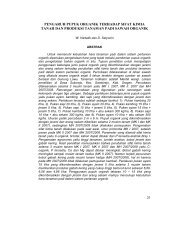Proceedings - Balai Penelitian Tanah
Proceedings - Balai Penelitian Tanah
Proceedings - Balai Penelitian Tanah
Create successful ePaper yourself
Turn your PDF publications into a flip-book with our unique Google optimized e-Paper software.
100<br />
Sembiring et al.<br />
tsunami. The most affected area was the north-west coast of the<br />
province, 50-80% food crop areas were badly damaged; around<br />
Calang, Lamno, and the north part of Banda Aceh the rice crop areas<br />
were severely destroyed (Gani 2005). The most damaged crop land<br />
was rice land, due to location of lowland rice at the lower coastal<br />
areas. If direct action is not taken to rehabilitate lowland rice area,<br />
NAD will not be self sufficient in rice, as it used to be.<br />
Table 1. Lowland rice damage by tsunami in some districts, NAD 2005.<br />
District<br />
Lowland rice area (ha)<br />
Total Damage<br />
Percentage of<br />
damage<br />
Aceh Selatan 17916 3627 20.2<br />
Aceh Barat Daya 18249 4520 24.7<br />
Aceh Barat 41538 6107 14.7<br />
Aceh Jaya 15529 4159 26.7<br />
Aceh Besar 30915 3574 11.2<br />
Pidie 38302 4023 10.5<br />
Bireuen 20507 1666 8.1<br />
Total 182956 27676<br />
Total (NAD) 336017 28931<br />
Source: Head of Dinas Pertanian Tanaman Pangan dan Hortikultura Provinsi NAD<br />
(personal communication, 2005).<br />
Disasters caused by tsunami were structurally, physically, chemically<br />
and biologically in nature, in respect to agricultural productivity. Top<br />
soil analysis (January 2005) of some tsunami-affected soils showed<br />
that soils had become saline-sodic, with EC of 4.27-15.18 dS m -1 and<br />
ESP of 13-72% (Gani 2005). More over, Rahman (2007) reported that<br />
the tsunami mud collected from 3 districts indicated a very high<br />
salinity ranged from 3.7 to 48.9 dS/m and salt content from 9,000 to<br />
26,000 ppm. Improper handling of this tsunami mud may contaminate<br />
the sub soil through tillage and infiltration, leading to an elevated<br />
increase of salt concentration in the sub soil. Further leaching of<br />
sodium may potentially contaminate the ground water which<br />
eventually be utilized by the community for their daily consumption.<br />
From field visit of ACIAR Team on September 2006, it is showed that<br />
salinity had decreased considerably. However, it is not only a need to<br />
enhance the leaching of both soluble salts and exchangeable sodium<br />
and magnesium to reduce their harmful effects, problems on nutrient<br />
imbalance after tsunami may be more important (Sembiring and Gani<br />
2007).<br />
International Workshop on Post Tsunami Soil Management, 1-2 July 2008 in Bogor, Indonesia



